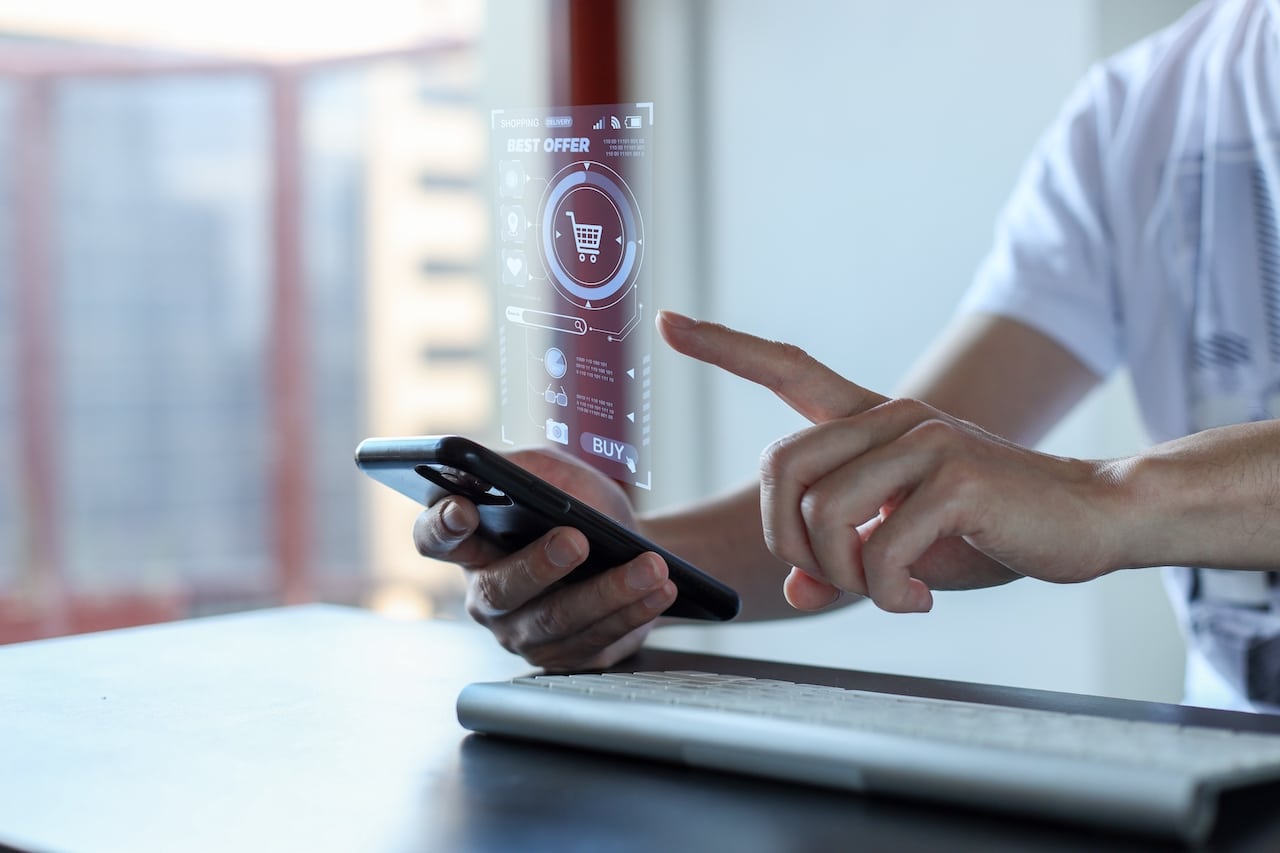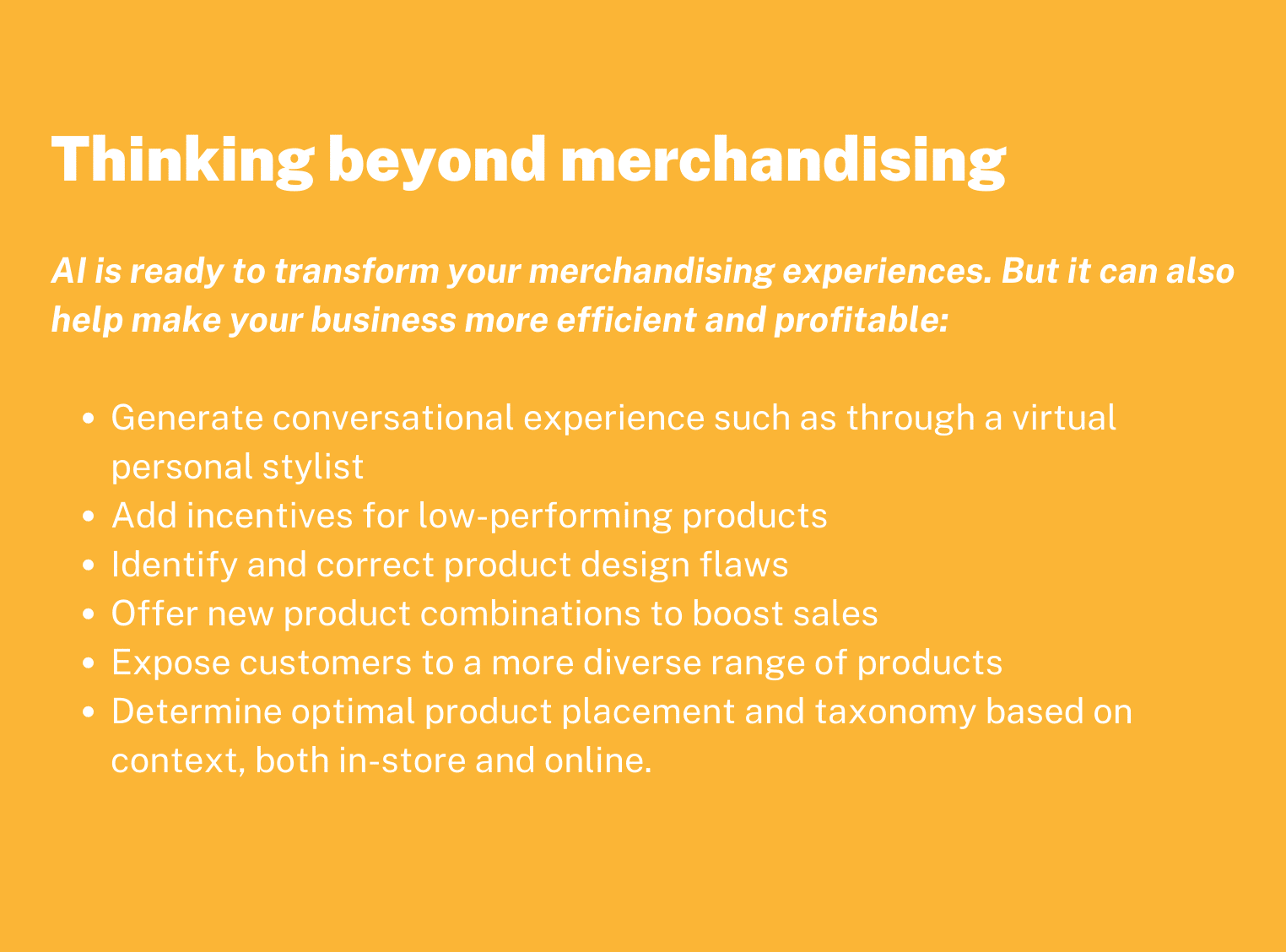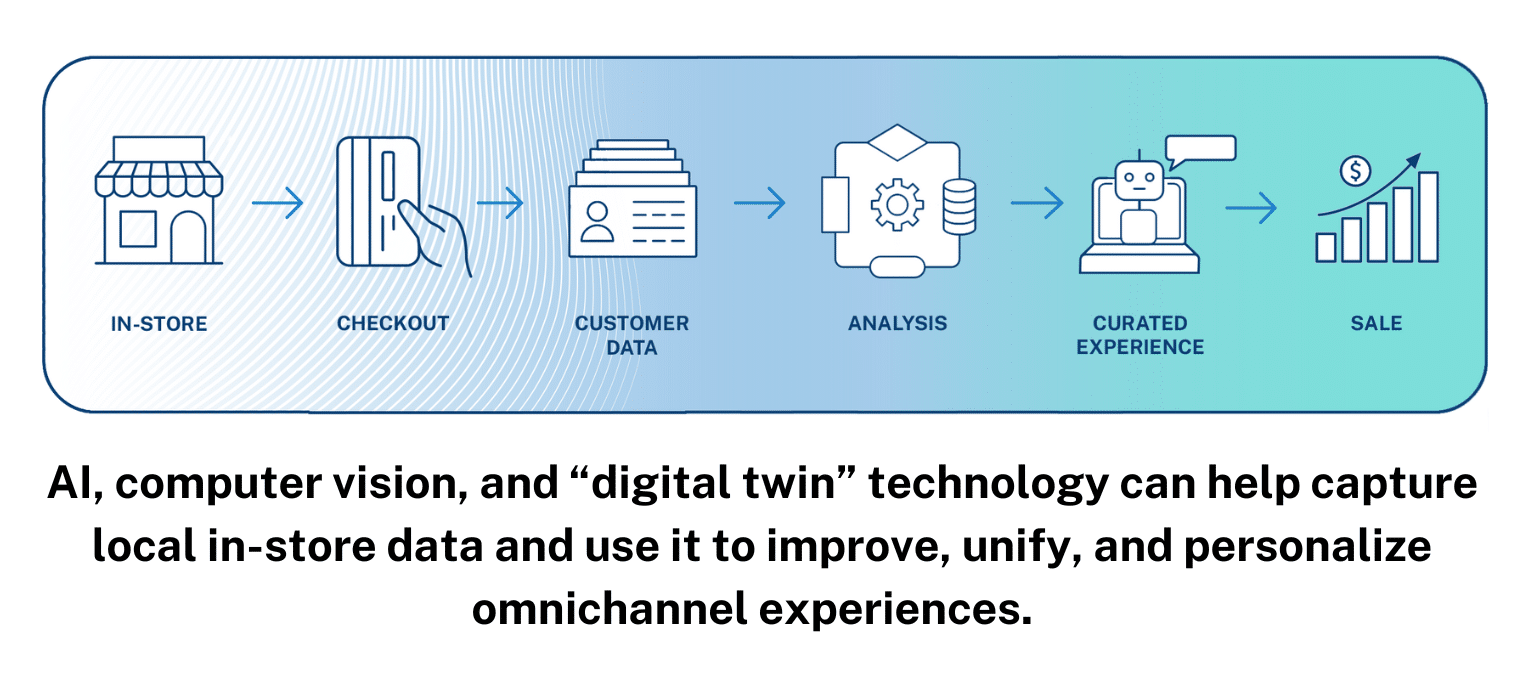4 Emerging AI Trends in Retail
Are these “AI in Retail” trends on your brand’s radar? They should be.

Artificial intelligence—in all its varied forms—has been impacting our lives and businesses for decades. But 2022 felt different. In many important ways, it was the year AI came out of the shadows and took center stage, as AI applications like ChatGPT and DALL-E popularized the latest AI technologies—and showed billions of people what they’re capable of.
But what does that all mean for the retail industry? Are there any AI developments that could have a “ChatGPT-level” impact on retail businesses in the coming months and years? And most important, what potential trends should you be paying attention to now as you think about how AI might impact your retail business in the future?
What “AI in retail” trends should you pay attention to in 2023?
It’s a complicated question. But here are four we think you should add to your list:
- Expanding AI insights beyond merchandising
- Using AI to build stronger omnichannel connections
- Turning simple chatbots into smart assistants
- Creating multimodal search experiences
1. CX is only the beginning: Expanding AI insights to every part of your business
Many “AI in retail” discussions tend to focus on creating smarter, richer, and more intention-based search and shopping experiences for customers—and for good reason. AI has incredible potential to transform how consumers find products and interact with your brand—from AI-powered visual and natural language searching to intelligent digital assistants. However, if you’re putting all your AI eggs exclusively in the customer experience basket, you may be missing opportunities to apply search-related data and insights to other parts of your business.
For example, AI algorithms can observe complex shopping and behavioral patterns to show how most customers are finding your business and starting their buying journeys, what buying paths are performing the best, which products are appearing less often in search results or experiencing higher levels of abandonment, and the list goes on. Then, based on those insights, you can take corrective actions, such as creating additional incentives for low performing products, continually refining your SEO strategies and product recommendations, correcting product design flaws, promoting new product combinations, and diversifying search results. In other words, this expansive approach can take you beyond the customer-facing benefits of AI to make every part of your business more efficient and profitable—from marketing and finance to product design and manufacturing.

2. Using AI to build smarter, stronger omnichannel connections
Retailers have been working for years to create more connected and unified shopping experiences across different channels, from physical stores and e-commerce websites to mobile apps and social platforms. AI has the potential to strengthen and enhance these connections in exciting new ways.
Here’s an example. Successful grocery store chains have perfected the art of tailoring the layout and merchandise in individual stores to the people who shop there—based on their in-store behaviors and buying patterns. A store in an affluent, established area with older residents might feature an expanded artisan cheese bar and endcap displays with wine and locally roasted coffee. In a newly developed part of town with lots of young families, the same retailer might emphasize more kid-friendly foods and low-cost bulk items. Those two stores are part of the same organization, they share the same brand, and they could very well be located just a few miles apart. But thanks to the hands-on, day-to-day knowledge of the people who work in those stores, they can each offer uniquely local and specialized experiences.
Physical retailers are also implementing new techniques and technologies to take these hyper-local in-store experiences to a new, more data-driven level. Many retailers are hiring experts to strategically place merchandise in ways that help consumers complete specific tasks—like preparing an Italian meal or installing a new faucet. Cameras and sensors can observe these shopping behaviors and buying patterns down to the individual shelf level. And ML technology can actively track and analyze those in-store patterns and recommend improvements.
Additionally, AI technology such as large language models can learn from the most popular recipes and underlying ingredients used from content posted on the web. AI-based tools like computer vision can “learn” recipes and extract ingredients from video media like YouTube.

These advances make it an exciting time for physical retailers. But in the past, it has been difficult (or impossible) to transfer these types of “neighborhood store” insights to other channels. Yes, retailers can personalize online browsing and search experiences based on customer profiles and past online purchases, but that rich collection of “here’s what sells best in this neighborhood” data has largely remained trapped inside the walls of individual stores.
That’s changing. Today, a few large retailers are using AI, augmented reality (AR), virtual reality (VR), and advanced camera and scanning technologies to create complete “digital twins” that replicate the precise layout and inventory of individual stores—all the way down to what’s sitting on each shelf. These detailed virtual representations can collect enormous amounts of data about traffic patterns, shoppers’ behaviors, the effectiveness of different pricing and merchandising strategies, inventory levels, and much more—and AI is constantly working behind the scenes to identify hidden patterns, connect the dots, and make recommendations that will make those stores more efficient and profitable.
This “digital twin” concept also frees that store-generated data to be used by other channels. So when a customer uses the store app to shop online, their AI-powered e-commerce platform can combine that user’s exact address with rich in-store data from a nearby physical store to provide more personalized digital search and shopping experiences. That could even include using shoppers’ own in-store shopping habits, preferences, and behaviors to create more cohesive and relevant online experiences.
Right now, this may all sound a bit futuristic—especially for smaller retailers. But a growing number of large retailers are actively implementing this type of AI-powered digital twin concept. The technology is becoming more proven and cost effective every day. And like any innovation that lowers costs, improves efficiency, and leads to better customer experiences, it will likely become a more common and practical option—and an important differentiator—sooner rather than later.
3. Turning rigid, limited chatbots into smart, conversational virtual assistants
The explosion of ChatGPT late last year has quickly shifted people’s expectations when they interact with a search engine or chatbot. To meet these expectations, businesses are actively working to integrate large language model AI technology into their online help, search, and other digital assistant functions. In the very near future, if your customers can’t describe what they’re looking for or explain a problem they’re having in natural, conversational language—and get relatable, relevant answers and recommendations back—they’ll probably walk away unhappy and start looking for alternatives.
Of course, turning rigid, limited chatbots into smart, conversational digital assistants involves much more than simply plugging a large language model like ChatGPT into your platform. You need to refine an LLM driven experience to be tuned with your business and customer’s intent. For example, a virtual stylist in luxury fashion, a virtual chef in grocery, a virtual tradesmen in home improvement. The dialogue with these assistants will be right on the mark as they will be more contextual to the domain and can be personalized to that shopper.
4. Creating richer, multi-modal shopping experiences
Every home DIYer has done this: You pull some weird broken flange, valve, or bolt out of an appliance or crawlspace. You drive down to the local hardware store. You find an employee who looks like they know what they’re doing, pull the thing out of your pocket, and say, “I need one of these.” If you accidentally left the broken thing back at your house and attempt to describe it verbally, it almost never ends well.
The same principle applies to online shopping experiences. Sometimes, typing text into a search bar just doesn’t cut it—no matter how advanced or intelligent your search algorithms are. That’s why multi-modal searches that can accept, analyze, and combine images, voice inputs, text descriptions, and other elements have become such an important priority for retailers.
AI has also reached the point where it can simulate and create accurate visual representations of how paint colors or furniture will look in a specific room, how clothing items will look on a specific person, and more. Thanks to AI, search is expanding to include different combinations of sights, sounds, and conversational descriptions. It won’t be long before the standard for modern, competitive search includes most or all of these multi-modal elements. We can expect to see this explored more AR and VR environments, such as chatrooms, shopping experiences, and more.
Getting (and staying) ahead of the latest “AI in retail” trends
These AI-focused trends and possibilities are intriguing. They can also feel a bit intimidating and out of reach, especially for smaller retailers. But adding these kinds of advanced capabilities—and staying ahead of the latest trends—becomes much more realistic and achievable with a smart approach, a future-ready technology platform, and the right expertise. At Lucidworks, it’s our business to explore, understand, and help you stay ahead of retail-related trends—and help make advanced “AI in retail” technologies more practical and relevant for your business. Find out how.
LEARN MORE
Contact us today to learn how Lucidworks can help your team create powerful search and discovery applications for your customers and employees.